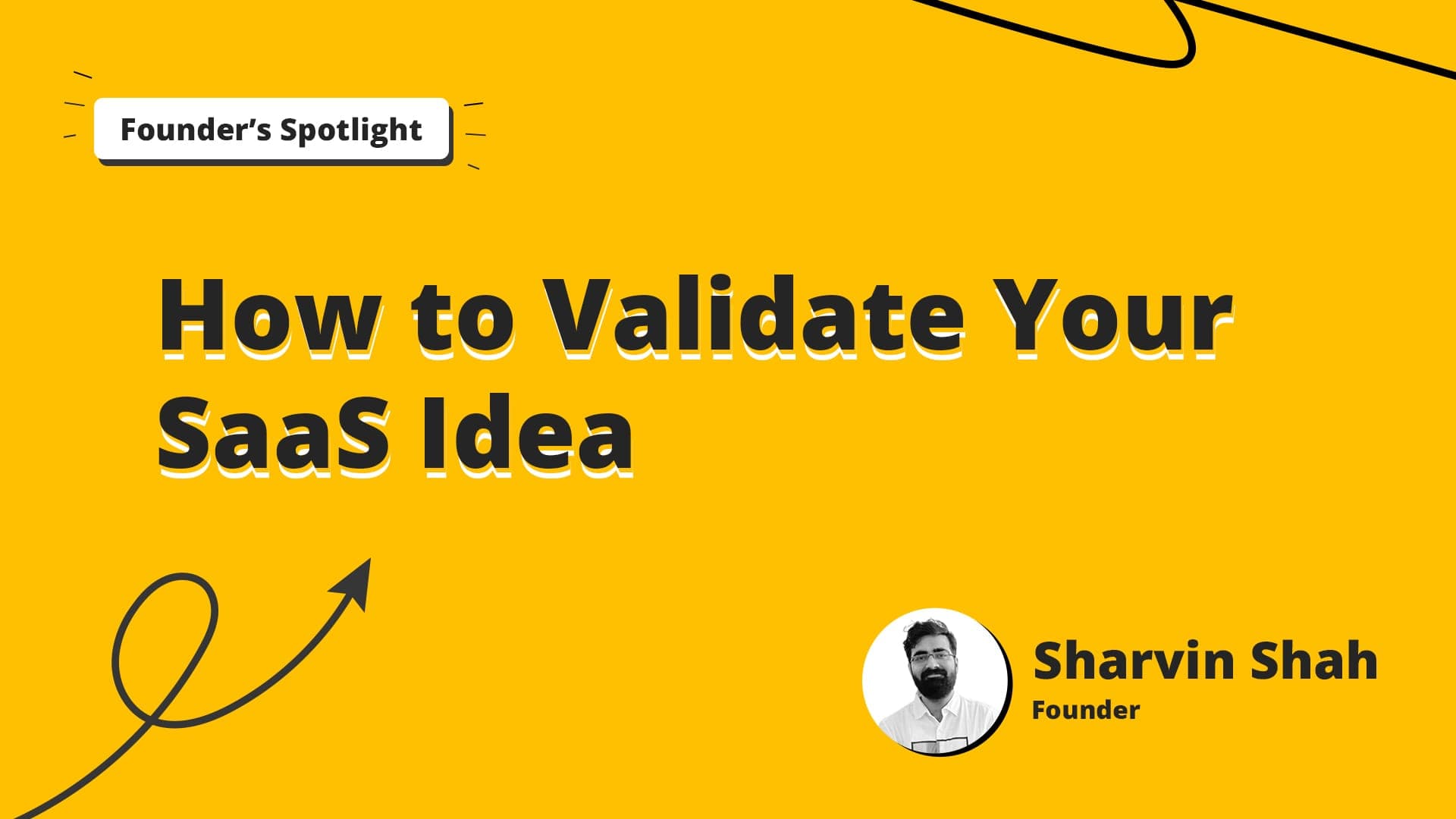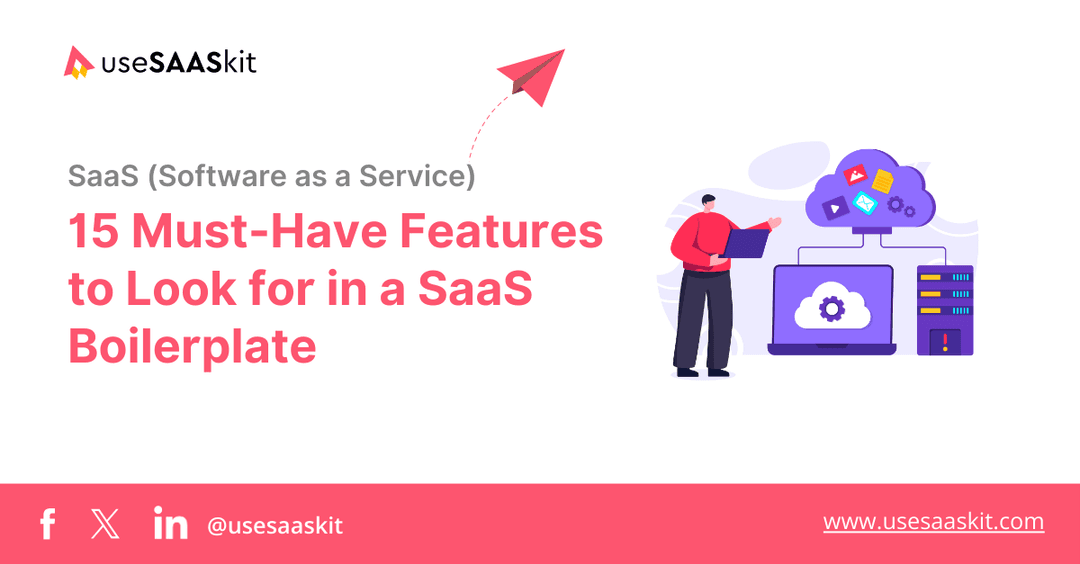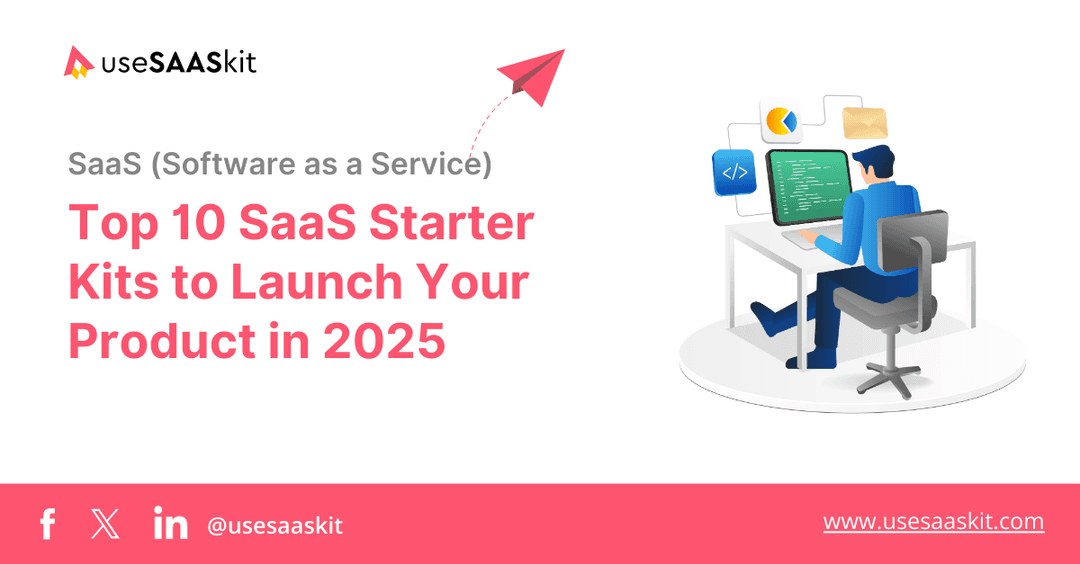Friday, 25 Oct 2024
11 min read
How to Validate Your SaaS Idea: Essential Steps and Tools

As a founder of multiple SaaS startups and a software developer with over nine years of experience, I have built more than 40 applications for different businesses. One key lesson I have learned is that having a great idea is not enough; you must validate your idea before you spend a lot of time and money on it.
In my journey, I’ve made mistakes, like focusing too much on building features that people didn’t care about and thinking that just collecting email addresses meant I had a successful product. After starting several projects, I realized that the best way to check if your SaaS idea will succeed is to talk to real potential users and try to sell your product early on.
As we move into 2025, this lesson is more relevant than ever. Many of us believe that if we create something we like, others will like it too. But the truth is, understanding what users want and need is very important. You need to listen to their feedback and be ready to change your idea based on what you learn.
By learning from my mistakes, I have put together a simple guide on how to validate your SaaS business idea. Along with my amazing team, we created a tool called the SaaS Idea Validator. This amazing free tool helps you quickly check if your idea is worth pursuing. It walks you through important questions to ask potential users and helps you see if people are interested in what you want to offer.
Let’s get started with the important steps!
How to Validate Your SaaS Idea: Step-by-Step Guide
Most SaaS founders know about the Build-Measure-Learn (BML) loop from The Lean Startup. Although this idea sounds good in theory, many founders find it hard to make it work in real life. This is important because a report from McKinsey shows that only 28% of software and internet service companies reach $100 million in revenue, and just 3% make it to $1 billion.
It’s easy to get caught up in your ideas and think that if you build something great, people will come. However, reality is often different. In the beginning stages of a SaaS product, many founders rely on hope and self-belief. You might think, “I’ll figure it out as I go.” While this attitude can help you move forward, it can also lead to disappointment if you're not careful.
Validating your SaaS idea means checking if people will actually use your product before you invest a lot of time and money in it. Following this guide will help you confirm your idea, minimize risks and set your startup on the path to success.

Step 1: Understanding Your Target Market For SaaS Success
Before you start building or investing in your SaaS product, it's important to understand who will use it. If you don't have a clear picture of your target market, you risk building something no one needs.
1. Define Your Ideal Customer Profile (ICP)
Start by describing the type of business or individual who will benefit most from your product. Here's what to include when creating your ICPs:
- Industry: Which industries will find your product useful?
- Company Size: Is your product better suited for startups, SMBs, or enterprise clients?
- Job Roles: Who will use your product? (e.g., marketing managers, HR professionals, developers)
- Demographics & Location: Where are your potential users located? Are there age or income brackets to focus on?
Tip: Look at your competitors' customers. Tools like LinkedIn and Crunchbase can help you analyze the types of companies and users your competitors are targeting.
2. Identify Your Customers Pain Points
Understanding your customers' problems is key to building a product they will actually use. This will help you get into the mindset of your customers and understand their challenges, motivations, and goals. Here are some questions you can ask:
- What tasks take you the longest to do at work?
- What software are you using now, and what don’t you like about it?
- What problems do you face when using these tools?
- What features do you wish your current tools had?
Preferred channels: Learn where your potential customers spend their time. It might be on LinkedIn, Facebook, industry forums, or other platforms. This will help you reach them and share your product in the right places.
Step 2: Analyze Your Top Competitors
Purpose of This Step: See how your product idea is different from similar software available in the market and what alternatives customers currently use.
1. Identify Your Competitors
- Use search engines to find products similar to yours. Type in keywords related to your product or service.
- Look for software review websites like G2Crowd, Capterra, or Software Advice to find competitors in your niche
2. Utilize Specific Tools
- G2Crowd: Use the platform’s comparison feature. You can see user reviews and ratings, which can help you understand what users like or dislike about different software.
- Social Media: Browse relevant hashtags on platforms like Twitter and LinkedIn to see who else is active in your market.
3. Use the Competition Analysis Spreadsheet:
Fill in your competitor information in the spreadsheet. You should have sections like:
- General Information: Name, website, and what they do.
- Pricing Model: Specify if they have a subscription model, pay-per-use, or a one-time fee.
- Pricing Plans: List out different tiers (e.g., Free, Basic, Pro, Enterprise) along with their monthly or yearly costs.
- Free Trials/Freemium: Note if they offer any free trials or a free tier of service.
- Major Features: Include a bullet list of the key features that make them stand out (e.g., integrations, automation, reporting).
- User Experience: Consider noting how easy the software is to use based on user reviews.
Try our free SaaS Pricing Generator to quickly generate three pricing plans for your SaaS product in minutes. This tool helps you find the perfect balance between value and price, ensuring your pricing stays competitive and supports long-term growth.
4. Understanding the Positioning
Create a simple diagram with two arrows. On one side, write down one position (like “Social Media Management”), and on the other side, write the opposite (like “Content Publishing”).
5. Criteria for Placement
- Focus Area: Consider what each competitor emphasizes most. Is it affordability, unique features, or customer support?
- Target Audience: Think about who their primary users are. Are they targeting small businesses or large enterprises?
- Market Presence: Assess their brand strength and how well-known they are in the industry.
Place each competitor on the diagram based on their strengths and market focus. This helps you visualize where your product can fit and what gaps you might fill in the market.
Step 3: Define Your Unique Value Proposition (UVP)
1. Find Out What Your Customers Need
- Use Surveys: Create a simple survey using tools like Google Forms or SurveyMonkey. Ask customers to rate their pain points and desired features.
- Conduct Interviews: Set up short calls or meetings with your target customers. Ask open-ended questions.
- Monitor Social Media: Follow relevant discussions on platforms like Twitter or LinkedIn. Look for posts where users express frustrations with existing tools.
- Check Review Sites: Use sites like G2Crowd, Capterra, or Trustpilot to read reviews. Identify common themes in complaints and praises about competitor products.
2. Highlight Unique Features
- List Your Features: Identify and list the standout features of your SaaS that directly address the pain points.
- Consider User Experience: Ensure your features enhance user experience, such as intuitive design or easy onboarding processes.
3. Explain the Benefits Clearly
- Use Simple Numbers: Whenever you can, share clear results that show how your features help customers.
- Focus on Real Outcomes: Make it easy to see what customers gain from using your software.
- Create Before-and-After Scenarios: Describe how a business operated before using your software and how it improved afterward.
4. Visualize Your UVP
- Use Design Tools: Utilize tools like Canva to create visually appealing infographics that summarize your UVP.
- Focus on Key Points: Highlight the pain points, your unique features, and the benefits in a simple, visually engaging way.
- Include in Presentations: When pitching to potential clients, use visuals to reinforce your UVP.
5. Integrate into Marketing
Use your UVP across all marketing channels, including your website, social media, and email campaigns, to ensure consistency in messaging.
6. Educate Your Team
Ensure that everyone in your organization understands the UVP. This will help maintain consistency in messaging across all touchpoints.
By following these tips, you can build a strong UVP that attracts customers and highlights what makes your product special.
Step 4: Build a Minimum Viable Product (MVP)
As a SaaS founder, I believe the best way to test my SaaS idea is by creating a Minimum Viable Product (MVP). This means building a simple version of my product that shows the main value it offers. Here’s how I approach it:
- Identify the Main Problem: I start by figuring out the main problem my customers have. For example, if I’m making an AI chatbot for customer service, I might find out that businesses have a hard time answering many questions quickly. They often get a lot of questions, and it can be tough for their teams to respond fast enough.
- Select Key Features: I pick a few important features that will help solve this problem. These features should show what makes my chatbot special.
- Focus on Usability: I ensure my MVP is easy to use. A simple and clear design helps users feel comfortable. I might use simple layouts and straightforward navigation so that users can easily understand how to use the product.
- Build the MVP: When developing my MVP, I focus on creating a working product that doesn’t frustrate users. If I include a feature for team collaboration, it should work smoothly.
- Launch to Early Users: I release my MVP to a small group of early users. This helps me gather their feedback. I can use surveys or direct interviews to find out what they think about the product.
- Collect Feedback: After launching, I pay attention to the feedback I receive. I look for common issues and suggestions. For example, if users say they want a calendar view for tasks, I take note of that.
- Make Improvements: Based on the feedback, I improve the MVP. I focus on fixing problems and adding features that users want. This helps me make the product better and more appealing.
- Measure User Engagement: I track how users interact with my MVP. I look at metrics like how often they log in and how long they stay on the app. Tools like Google Analytics can help me see this data.
- Explore Pricing Options: Once users show interest, I think about how to monetize my MVP. I might offer a free trial or a basic version for free, then charge for advanced features. If users find my product helpful, they may be willing to pay for it.
By building a Minimum Viable Product (MVP), you can test your SaaS idea and see if it meets your customers' needs. This step helps you improve your product based on real feedback from users, getting you ready for more development.
Step 5: Test and Gather Feedback from Early Users
This step is crucial because it helps you understand how your product performs in real-world situations and what improvements are needed.
1. Find Early Users
To test your MVP, you need to find people who will actually use it. These could be people in your network, online communities, or those interested in the problem your SaaS solves.
- Example: If you’re building an AI chatbot for customer service, join online groups (like LinkedIn or Facebook groups) where business owners or customer support teams gather. Share your chatbot there and offer them a chance to try it out.
- Mediums to use: LinkedIn groups, Reddit communities, Facebook groups, SaaS forums, or your own email list.
2. Offer Free Trials or Beta Access
To encourage users to try your product, you can offer free trials or invite them to become part of a beta test group.
- Example: You could offer a free 30-day trial of your AI chatbot for companies, letting them test how well it helps answer customer questions.
- Mediums to use: Email marketing, social media posts, beta signup pages on your website.
3. Gather Feedback Through Surveys or Interviews
Once users are using your MVP, ask them for detailed feedback.
- Example: Send users a survey asking:
- How easy was the chatbot to set up?
- Did it improve their customer support experience?
- What features did they find most useful or frustrating?
- Tools to use: Google Forms, Typeform, or directly through email.
4. Track User Behavior
While you’re gathering feedback, also track how users interact with your product. This helps you understand what features they use the most and where they encounter problems.
Tools to use: Analytics tools like Google Analytics can help you see which features users engage with most.
5. Analyze and Act on Feedback
Once you’ve gathered feedback, look for patterns or recurring issues. If many users are pointing out the same problems or requesting a specific feature, that’s a clear sign of what you need to improve.
Step 6: Use the SaaS Idea Validator Tool to Confirm Your Concept
Once you’ve gathered feedback from early users, the next step is to make sure your idea is ready for the market. This is where we recommend using the SaaS Idea Validator Tool to validate your concept before investing more time and money into development. This tool helps you see if there’s a real demand for your product and if it solves a genuine problem.

Here’s how the SaaS Idea Validator Tool works in 3 simple steps: https://www.usesaaskit.com/free-tools/saas-idea-validator
How this SaaS Idea Validator Tool Helps You
- Simple and Easy to Use: Just enter your business idea and target audience, and the tool guides you from there!
- Understand Your Market: Identify market gaps and validate your idea against real market demands.
- Find Your Audience: Define your target audience and their needs for better results.
- Save Time and Resources: Early validation helps you avoid product pivots or failure.
Best Practices for Validating Your SaaS Idea: Quick Tips
1. Test Your Idea Before Development
Try to make some sales before you create your product. Show a simple demo to see if people are willing to buy it.
- Create a landing page explaining your idea and see if visitors sign up for more information.
- Conduct pre-sales by offering a discounted price for early adopters before building the product.
2. Talk Directly to Potential Users
Reach out to potential customers through calls or messages. Personal chats can help you understand their problems better.
- Make a list of people to contact.
- Use LinkedIn Sales Navigator for finding leads.
- Set a daily goal for how many people you’ll reach out to.
3. Use Marketing Data to Learn
Check your marketing data to see how people respond to your website and ads. Look at things like clicks and how long visitors stay on your site to understand if there’s interest.
- Set up Google Analytics to track visitors.
- Use tools like SEMrush to see how competitors are doing.
- Regularly check your analytics dashboard for important numbers.
4. Ask Questions, Don’t Sell
Treat your calls like interviews. Ask open-ended questions to learn about their challenges before presenting your solution.
- Prepare a list of questions to guide your conversations.
- Use scheduling tools like Calendly to arrange calls easily.
- Keep each interview to about 20 minutes to stay focused.
5. Know When Your Idea is Validated
You’ll know your idea is good when you have real customers willing to pay for it. Set clear goals, like getting a certain number of paying customers.
- Define specific goals for validation (e.g., number of customers).
- Use spreadsheets to track customer interest and sales.
- Regularly review your sales and feedback data to measure your progress.
Conclusion
I hope this blog has answered many of your questions as a SaaS startup founder or as someone seeking the right path forward.
There were moments when my ideas didn’t connect with users, and it was tough to deal with that disappointment. However, each setback taught me important lessons about understanding what customers really want and how to improve my approach. I learned that validating my SaaS ideas before starting development is crucial.
What matters is that you learn from each experience and keep pushing forward. I encourage you to use a SaaS idea validator; it can really help you avoid common mistakes and guide you in creating something valuable.
All the best.


